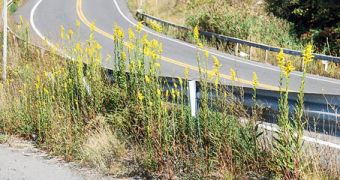A scarce plant once populating the inland salty marshes of upstate New York was thought to have gone extinct. But recently, the rare species of goldenrod appeared from nowhere, in a surprising place: on the sides of the local roads.
The re-emergence of the rare plant surprised the specialists. If anyone expected this comeback, it certainly was not believed to happen elsewhere than the original place the goldenrod once occupied, the four remaining (out of several thousands) salty marshlands, three of which are in New York and one in Michigan. Instead, the plant chose a different place for its resurrection, as it flanked the streets of the area. The re-established species was accidentally discovered during a regular walk by Dr. Leonardo from the SUNY College of Environmental Science and Forestry (ESF), who believes it may have adapted well as the sole ruler of the salty zone which deters other plants from growing. The plants were only discovered on two more sites.
“They're coming out of asphalt, with no soil anywhere, and it's striking because they're all blooming right now. It's a visually spectacular plant,” said Dr. Leonardo, quoted by Syracuse. The seaside goldenrod can reach 8 feet (about 2.5 meters) in height and yields rich, yellow blossoms atop its dark-green leaves and stems. It was believed to cause allergies (but the blame falls on its neighbor plants, the simultaneously-blooming ragweed). It proves a valuable nectar source for the insects that are still around in the late season when the goldenrod blooms.
The plant is not only a blessing for insects, but also for the people involved in urban gardening. “We've been trying to find native species to use in a green approach to handling urban run-off. Not only is this plant beautiful, it is quite functional. Instead of building a multi-million treatment plant or allowing the run-off going into our creeks and streams, it looks like this could provide a natural solution,” Dr. Leonard explained in a Weather Channel article. The goldenrods cost nothing to grow and maintain and are better as greenhouse plants, which proves their superiority when compared to rich imported species.

 14 DAY TRIAL //
14 DAY TRIAL //